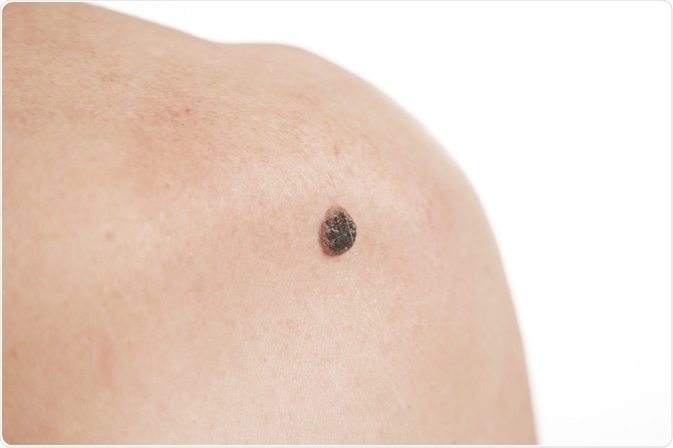Timely treatment of squamous cell carcinoma is important, as this type of skin cancer can grow rapidly, create more severe cosmetic and functional damages, and/or metastasize to other areas of the body.
The management plan depends on the individual characteristics of the patient’s condition, such as the size and location of the carcinoma, the extent of spread, and other concurrent health conditions.

Image Credit: SERGEI PRIMAKOV / Shutterstock.com
Surgical removal
The surgical removal of squamous cell carcinoma is the most common and effective method used in the management of the condition. There are several different types of surgical techniques that may be recommended, depending on the specific case.
Cryosurgery involves the application of liquid nitrogen to the affected area, which works to freeze the abnormal tissue and allow the underlying healthy cells to grow back in place of the carcinoma. This is most effective for small carcinomas that do not extend deep into the skin.
Curettage and electrodesiccation is a common treatment that is very effective for low-risk tumors. The procedure is carried out under local anesthetic and involves scraping away the cancerous tissue with a curette, followed by the use of an electric needle to manage bleeding and destroy any remaining cancerous cells.
Surgical excision of the tumor is most commonly practiced for high-risk tumors that have a distinct border. The procedure is carried out under local anesthetic and involves the removal of the tumor as well as a margin of healthy skin, followed by the closure of the wound with sutures. This can be performed in any area of the body and allows the removed tissue to the analyzed in a pathology laboratory for evidence that the entire tumor has been removed.
Mohs surgery is often used, particularly with high-risk tumors that are likely to recur following treatment. This procedure involves the removal of one layer of skin, which is immediately examined for signs of cancerous growth under a microscope. Layers of skin continue to be removed until there are no signs of abnormal cell growth. Although this method is complex and time-consuming, it is very precise and helps to ensure that the tumor is removed in its entirety, thus reducing the risk of recurrence and skin scarring.
Of all of the surgical procedures used in practice, Mohs surgery is the preferred method for high-risk squamous cell carcinomas that are large in size and extend deep into the skin.
Radiation therapy
Radiation therapy can also be used in the treatment of squamous cell carcinoma and is particularly useful if the cancer has spread to surrounding lymph nodes or other organs in the body. This treatment option is usually used in older patients who do not tolerate surgery well.
The procedure involved the administration of X-rays or high-energy particle radiation that are directed toward the affected area in the body. The radiation can effectively destroy tumor cells and help to reduce the risk of recurrence.
In most cases, the total dose is administered with repeat sessions of smaller doses over three to four weeks. This helps to reduce the risk of side effects, such as burning of the skin that can change the long-term cosmetic aspect of the skin.
Topical medications
Creams or lotions to be applied topically to the affected area can also be utilized in the management of superficial squamous cell carcinoma, which helps to minimize the systemic effects of potentially toxic chemotherapy medications. This is usually used in low-risk cases, as the cure rates are lower than other therapies for tumors associated with higher risk.
Fluorouracil (5-FU) is an example of a topical cream or lotion that can be applied daily for three to six weeks. This may produce mild skin irritation, but the systemic effects are minimal. Imiquimod can also be applied topically, causing the immune cells to attack abnormal tissue and treat actinic keratosis.
Other therapies
Photodynamic therapy is often used in the management of actinic keratosis, which can progress to squamous cell carcinoma. The high-intensity light activates a chemical to destroy cancer cells on the surface of the skin.
Laser surgery involves a focused beam of light that is directed towards the tumor cells. It is effective at destroying cancer cells on the surface of the skin but should not be used for deeper tumors.
Follow-up and monitoring
It is important for patients who have had squamous cell carcinoma to receive appropriate follow-up care, including close monitoring for skin changes that may indicate the growth of the cancerous cells.
References
Further Reading
Last Updated: Feb 21, 2023